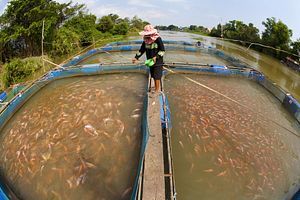Efforts to reduce malnutrition have resulted in 200 million fewer hungry people worldwide since 1990. But 805 million people still deal with chronic hunger every day. In the fight against poverty and malnutrition, smart nations have found success by developing self-sufficient food sources, promoting economic growth and engaging women in business enterprises.
A leading example is Bangladesh, which used this formula to cut chronic hunger by more than half since 2000, according to the United Nations. The U.N. also says that Bangladesh has reduced the number of underweight children by 25 percent.
Just four decades ago, Bangladesh was a newly formed, impoverished nation facing high levels of extreme hunger when floods and famine destroyed what few resources it had. With desperately high demand, imported food grew scarce and 1.5 million people died from famine and sickness. Those terrible times forced Bangladesh to take action to increase its food security and self-sufficiency.
In the 1980s, Bangladesh started to build small-farm irrigation systems, increasing rice production and, most important, developing cutting-edge aquaculture practices. It also identified more than 1 million abandoned ponds, roadside canals, ditches and seasonally flooded pools as potential sources of fish production. Bangladesh, it turned out, was full of small bodies of water – some as small as a backyard swimming pool – that had the potential to become mini-fish-factories, churning out protein and income.
By helping local residents develop effective aquaculture techniques, Bangladesh now has more than 500,000 previously unused seasonal ponds teeming with fish. These farms helped boost Bangladesh’s fish yields eight-fold in just the first year. Fish production grew at a 300 percent rate during the 1990s.
Bangladesh farmers learned to recycle farm waste, such as rice bran, weeds and manure, to support and grow larger fish. Polyculture techniques of raising multiple species of fish in one pond allowed local farmers to feed and harvest more varieties with higher nutritional value. By raising fish species such as tilapia and silver barb that can thrive in cloudy, shallow waters, Bangladesh’s annual fish production has continued to flourish.
An additional key to Bangladesh’s aquaculture success has been the involvement of women. Traditionally, only males worked outside the home in Bangladeshi families. But one source of income was often not enough to prevent poverty, so female employment has been essential to bringing in extra food and money.
As it turned out, women made particularly effective fish farmers because the farms were generally located nearby, allowing them to work well both inside and outside the home. This seasonal and lucrative employment opened the way for thousands of women to be entrepreneurs and also contribute to the stability of their households. In Bangladesh today, more than 60 percent of fish farmers are women. Female participation in the workforce has increased incomes in rural households, bolstered nutrition and enhanced the status of women within the family and society.
In some families, women are now earning more than their husbands. Before women were brought into fish farming, husbands would eat first, then the children, by cultural tradition. Wives would eat only what was left over and their calorie intake was 30 percent less than their husbands. But as a result of their participation in fish farming, women now often eat on par with their other family members and have a say in running the family. This empowerment of women is also leading to better education for children.
Aquaculture plays a vital role in providing nutrition and jobs in developing nations worldwide.
But more aquaculture is needed. The amount of farm-reared fish must increase from 66 million tons annually to 93 million tons by 2030 to maintain current levels of per capita global fish consumption, the U.N.’s Food and Agriculture Organization says. Unfortunately, governments have yet to fully realize the importance of aquaculture for nutrition and job creation. National budgets in developing countries allocate much larger amounts to crop and livestock than to fish.
Other developing nations should take Bangladesh’s lead and emphasize aquaculture farms because they provide a sustainable, growing source of nutrition and income. The added benefits to women and society at-large are an undeniable bonus.
Modadugu Vijay Gupta, who won the World Food Prize in 2005 for developing low-cost fish-farming techniques, is co-recipient of this year’s Sunhak Peace Prize.

































